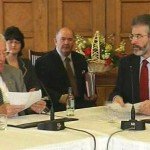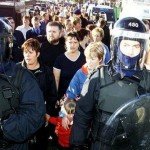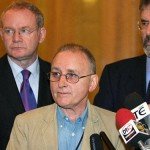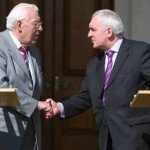
Post-Troubles government in Northern Ireland was plagued by political division and distrust. These problems continued into the new millennium, despite the partial resolution of the decommissioning crisis in late 2001. Within Northern Ireland’s power-sharing Executive, Unionists and Sinn Fein members found it difficult and at times impossible to work together. Meanwhile, tension and violence continued on the streets of Belfast, sparked by sectarian protests outside a Catholic primary school. Allegations of espionage in October 2002 led Westminster to suspend the Northern Ireland government for the fourth time in its brief history. Direct Rule would remain in place for almost five years. By 2005 the political situation was even more polarised, with the Democratic Unionist Party (DUP) and Sinn Fein growing to become Northern Ireland’s largest parties. It would take another landmark peace deal, the 2006 St Andrews Agreement, to bring them together and restore devolution in Northern Ireland.
Suspicion and mistrust
In October 2001 the Provisional IRA agreed to decommission and allow international inspectors to verify its weapons had been put “out of use”. While this ended the impasse between Unionists and Sinn Fein, it did not end political distrust or tension within both camps. David Trimble was reelected First Minister in early November 2001, despite members of his own party voting against him. Trimble’s election did not please the Democratic Unionist Party (DUP), which believed he had sold out to the Republicans. When Trimble attempted to address the Assembly on November 6th he was heckled by DUP representatives, who called him “traitor” and “Provo lover”. This triggered a brawl on the floor of the assembly, DUP members scuffling with Nationalist and Sinn Fein deputies. Over the next few months Trimble, his fellow Unionists, the DUP and Sinn Fein continued to snipe at each other over a range of issues, from decommissioning to policing reform to bureaucratic appointments.

The political turmoil of 2001-2002 was accompanied by a series of sectarian protests and clashes outside a Belfast primary school. Holy Cross is a Catholic girls’ school in Ardoyne, a Protestant area of North Belfast. In June 2001 local Protestants began picketing the area, abusing and intimidating parents and students as they walked to and from school. Loyalist paramilitaries also issued death threats against teachers and parents. In September 2001 the new school year was ushered in with more protests and violence, albeit with a stronger police presence. The protests were revived in January 2002 and produced a fresh wave of confrontations, abuse, threats, assaults and property damage. Rioting also broke out elsewhere in Ardoyne and North Belfast, incited by Loyalist thugs. Leaders on both sides condemned the protestors for targeting and terrifying young schoolgirls. These protests faded away after 2002, though Holy Cross and other Catholic schools were occasionally attacked or bombarded with Loyalist graffiti.
‘Stormontgate’

In October 2002 the Police Service of Northern Ireland (PSNI) raided Sinn Fein offices, following allegations of a Republican spy ring inside the government. A Sinn Fein administrator, Denis Donaldson, was charged with gathering information for Sinn Fein and the Provisional IRA. This information included transcripts of telephone calls involving Tony Blair, United States president George W. Bush and Unionist leaders, as well as information on British soldiers, police officers and prison staff. Some claimed this information was used by Sinn Fein during 2001 talks on decommissioning. These allegations created an uproar among Unionists. David Trimble called it “political espionage on a massive scale… ten times worse than Watergate”. Sinn Fein denied all allegations of spying, blaming members of the security forces for seeking to sabotage the peace process. Whatever the realities, Northern Ireland’s power-sharing government had become unworkable. Westminster responded by suspending the Executive on October 14th and reimposing Direct Rule.

The investigation into ‘Stormontgate’, as it became known, would take more than three years. It ended with no prosecutions and produced no clear outcomes. Charges against Donaldson and two other men were dropped in December 2005. Direct Rule remained in place through this period and beyond. There were several rounds of talks between British and Irish leaders, along with Northern Ireland’s political parties, about holding fresh elections and restoring devolution – but these negotiations achieved little. Some progress was made in 2004. In February the Ulster Defence Association (UDA) declared a new ceasefire and a commitment to a negotiated peace. In October Ian Paisley met with Irish taoiseach Bertie Ahern in Dublin. This marked a significant shift in Paisley’s position, the DUP leader previously refusing to negotiate with Nationalists or Republicans. Paisley’s DUP also emerged victorious in the May 2005 British election, winning nine seats in the House of Commons compared to the UUP’s single seat. The DUP was now the largest Unionist party in Northern Ireland, making Ian Paisley a key figure in the fate of the peace process.
The IRA lays down its arms
There were more significant developments to come. On July 28th 2005 the Provisional IRA formally announced that it was ending its armed campaign in Northern Ireland. Two months later General de Chastelain, head of the Independent International Commission on Decommissioning (IICD), reported the Provisional IRA had put all its weapons out of use. In August Tony Blair announced that Britain’s military presence in Northern Ireland would be more than halved. Blair and Bertie Ahern spent the next six months trying to restore devolved government to the Six Counties. The Northern Ireland Assembly was recalled on May 15th 2006 and given until November to elect an Executive. Now the leading Unionist in the Assembly and the likely candidate for First Minister, Paisley remained defiant that he would never share power with Sinn Fein. In the summer of 2006 he told a meeting of the Orange Order:
“No Unionist who is a Unionist will go into partnership with IRA-Sinn Fein. They are not fit to be in partnership with decent people. They are not fit to be in the government of Northern Ireland. And it will be over our dead bodies that they will ever get there… Ulster has surely learned that weak, pushover Unionism is a halfway house to Republicanism. There is no discharge in this war… Compromise, accommodation and the least surrender are the roads to final and irreversible disaster. There can be no compromise.”
Showdown at St Andrews

Paisley’s stubbornness, it seemed, might condemn Northern Ireland to years of political division and Direct Rule. Blair and Ahern initiated one last attempt to rescue the peace process and devolution, scheduling multiparty talks for mid-October. These talks, held in the Scottish golfing town of St Andrews, were attended by all Northern Ireland’s political parties. The focus, however, was on convincing the DUP and Sinn Fein to form a government and work together. As with other cross-party talks the St Andrews meetings rode the cusp of failure. Paisley and the DUP were ready to walk out after the second day; only a raft of concessions from Blair convinced them to stay. When the talks concluded, ironically on Friday 13th, delegates returned to their party members with a timetable for restoring devolution and a set of agreed principles. Among these were the DUP’s acceptance of power-sharing with Sinn Fein, as well as Sinn Fein’s full acceptance of the Police Service of Northern Ireland (PSNI).
“The St Andrews Agreement, though much less well known than the Belfast Agreement, has claims to virtually equal significance. It has been sardonically described by Reg Empey, one of the two members of the Executive from the once dominant UUP, as ‘the Belfast Agreement for slow learners’.”
Michael Moran, academic
The St Andrews Agreement, as it became known, cleared the largest obstacle to power-sharing. While Paisley and Adams maintained their bluster and bickered over details, both parties had now committed to sitting together in a new Executive. “This time, everybody is inside the tent, including Ian Paisley”, observed one British official. Elections in March 2007 confirmed the DUP (36 seats) and Sinn Fein (28 seats) as the two largest parties in the Assembly. The parties spent April selecting their ministerial appointments. On May 8th 2007 Direct Rule was ended and devolution restored to Northern Ireland. Ian Paisley and Martin McGuinness were confirmed as First Minister and Deputy First Minister respectively. As the former Catholic-hating firebrand and the former Provisional IRA commander were sworn in together, it appeared Northern Ireland’s widest political chasm had finally been bridged.

1. The St Andrews Agreement was negotiated by Britain, Ireland and Northern Ireland’s political parties in Scotland in October 2006. It cleared the way for the restoration of devolution.
2. Progress on IRA decommissioning in October 2001 failed to ease political tensions, while in 2001-2002 Belfast was rocked by sectarian protests outside a Catholic primary school.
3. In October 2002 Northern Ireland police claimed to have uncovered an IRA-Sinn Fein spy ring. This made government unworkable and led to the British suspending devolution.
4. Northern Ireland remained under Direct Rule for five years. Despite the Provisional IRA ending its armed campaign Paisley refused to share government with Sinn Fein.
5. The St Andrews deal provided a timeframe for the restoration of devolution and a set of agreed principles that would allow the DUP and Sinn Fein to share power in a new Assembly and Executive. This culminated in the election of Ian Paisley and Martin McGuinness as First Minister and Deputy First Minister in May 2007.

The Provisional IRA announces the end of its armed campaign (2005)
Blair and Ahern’s agreement for restoring devolution (2006)
The St Andrews Agreement (2006)
The Journey (2016 film)
© Alpha History 2017. Content on this page may not be republished or distributed without permission. For more information please refer to our Terms of Use.
This page was written by Rebekah Poole and Steve Thompson. To reference this page, use the following citation:
R. Poole and S. Thompson, “The St Andrews Agreement”, Alpha History, accessed [today’s date], https://alphahistory.com/northernireland/st-andrews-agreement/.
